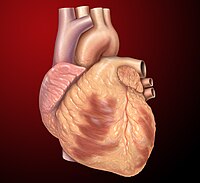
Photo from wikipedia
Abstract Funding Acknowledgements Type of funding sources: None. Background/Introduction Transthyretin cardiac amyloidosis (ATTR-CA) is associated with an increased incidence of arrhythmias. We hypothesized that non-invasive, two-week outpatient cardiac rhythm monitoring… Click to show full abstract
Abstract Funding Acknowledgements Type of funding sources: None. Background/Introduction Transthyretin cardiac amyloidosis (ATTR-CA) is associated with an increased incidence of arrhythmias. We hypothesized that non-invasive, two-week outpatient cardiac rhythm monitoring of patients with ATTR-CA would detect high rates of ventricular tachycardia and atrial fibrillation/flutter (AF). Purpose To characterize arrhythmia in patients with ATTR-CA on two-week, non-invasive cardiac rhythm monitors. Methods 38 patients with ATTR-CA (mean age 76.9 SD 10.0 years, 89.5% male) who underwent two-week remote external patch monitoring were included in this single center retrospective study. An age-matched control group included 38 patients (mean age 73.9 SD 12.3, 76.3% male) who underwent the same cardiac rhythm monitoring as part of neurological workups. Results NSVT was detected on the remote monitor in 81.6% of ATTR-CA patients and AF was detected in 26.3% of patients. ATTR-CA was associated with higher rates of NSVT and AF compared to the control group (28.9% with NSVT and 5.3% with AF). As seen in Figure 1, there were only three ATTR-CA patients without either AF, NSVT, advanced atrioventricular block, or a significant pause detected on remote monitor. Among the ATTR-CA group, at median 45 weeks follow-up, there were 4 heart failure hospitalizations, 2 cardiovascular events (1 episode of sustained VT and 1 stroke), 6 permanent pacemakers placed, and 3 implantable cardioverter-defibrillators placed, including one for sustained VT. NSVT and AF were not associated with a composite of these adverse outcome. Conclusion ATTR-CA was associated with high rates of NSVT and AF on noninvasive remote monitors. While evidence regarding the management of arrhythmias, particularly NSVT/VT, in ATTR-CA remains limited, two-week noninvasive cardiac monitoring can be considered to aid in risk stratification for both atrial and ventricular arrhythmias in ATTR-CA.
Journal Title: Europace
Year Published: 2023
Link to full text (if available)
Share on Social Media: Sign Up to like & get
recommendations!